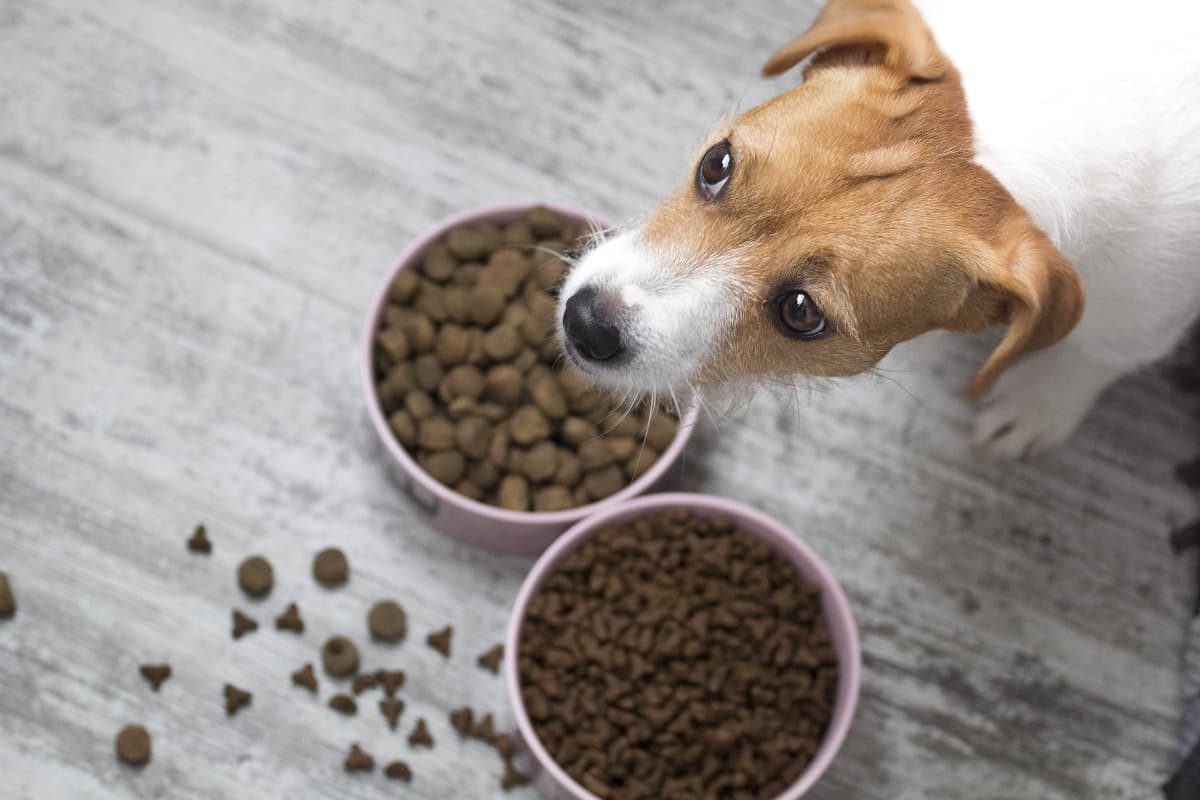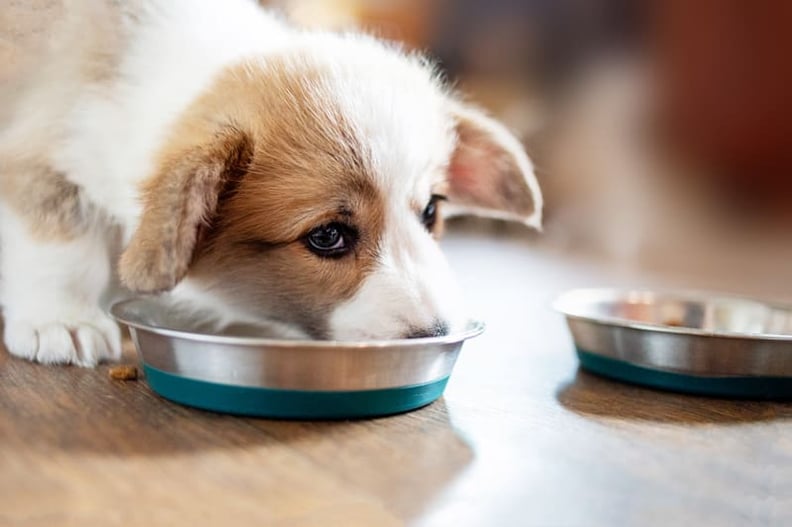
Changing your dog's food is one of those things that shouldn't be that hard, but one bad experience can leave you feeling a little hesitant to make the next switch.
Find out everything you need to know about changing dog food so your doggo doesn't have any adverse reactions. There is a healthy way to change your dog's food and we will explore those options in this article.
We eat different foods every day at every meal, but we feed our dogs the same diet over and over again. Dogs who eat one diet for a long time are not accustomed to recognizing and digesting new foods very well, so when you do end up changing their food, your dog might be surprised with some unpleasant digestive reactions which is why you should transition food gradually.
Knowing how to change your dog's food safely can reduce reactions and help your dog adapt to his new diet quickly.
If your pooch has been lucky enough to not have any food allergies, weight problems, or other health issues, then you may have never had to worry about changing your dog's food yet. The chances are though, at some point in your dog's life you are going to need to change their diet for one reason or another.
Whether you need to change your dog's diet to treat an issue or just to give your dog a little flavour variety, knowing how to change dog food safely is important.
Is It Good to Switch Up Dog Food?
There are many reasons you might change up your furry friend's food, like when you are managing dog food allergies or other health issues, but there is also value in switching your canine's food to provide your dog with more ingredient and nutrient variety.
Routinely offering different nutrients so your dog can benefit their overall health. This is called rotational feeding.
Problems With Feeding the Same Dog Food
The popularity of commercial dog foods focused on convenience, and we got used to the concept of a single consistent dog diet, but the truth is that feeding the same diet, day in and day out, can lead to some problems.
-
Boredom: Canines who eat a single diet are more likely to get bored or disinterested in their meals.
-
Weight and Nutrient Problems: Poor eating habits can lead to weight issues and nutrient deficiencies, especially if you supplement with dog treats and table scraps to encourage eating.
-
Food Sensitivities: Some canines need grain-free formulas after developing allergies. Though we don't know for sure what causes food sensitivities and allergies, it's possible that feeding the same old food over long periods of time could lead to the development of these sensitivities. One of the driving forces for food change remains health reasons.
Rotational feeding may help prevent the development of food allergies or digestive sensitivities in dogs.
Transition From Puppy Food To Adult Dog Food

For most pet owners, the first time you change dog foods might be when your dog goes from puppy to adult. Growing puppies requires some additional nutrients, but switching to a maintenance formula will help keep your dog lean and healthy once your puppy is full-grown.
This switch can be done as slowly as is needed, and the diet changes are typically less drastic between puppy and adult formulas of the same brand.
When to Switch Puppy Chow to New Dog Food
Most puppies need to transition to adult food around 1 year old, though age and breed may be factors here. Larger breeds may grow up to 18-24 months, so they can stay on a large breed puppy food longer than smaller breeds.
The best way to tell when your dog is ready to transition from puppy food to adult is to monitor their weight. Dogs tend to reach full height and length before reaching their adult weight range, so monitor their weight and muscle development using the dog body conditioning score.
This can help determine if your puppy is ready to switch to adult food. Adult dogs fed puppy food can gain excess weight and maybe consume higher levels of nutrients, like calcium, than they require, which could lead to problems as they age.
What Happens If You Change Your Dog's Food Too Fast?
If you are feeling impatient or need to switch your pup's old food rapidly, you need to be prepared for possible consequences such as your dog's digestive tract acting up.
Some dogs have an "iron stomach" and rarely experience issues when introducing new foods or ingredients, but even the most digestively sturdy dogs can experience problems when their food is changed too quickly.
The severity of reactions can depend on many things, like the quality of the current dog food versus the new food you are changing between, your dog's current gut health, and the type of diet you are switching to. You'll want to pick a food that offers balanced nutrition so you can make the diet transition as easy as possible to avoid food sensitivity and stomach upset.
If your dog refuses the new food, use a meal topper or mix a little wet food in the dry kibble to make it more enticing.
Digestive Aids to Help Switch Your Dog's Food
Diet changes are inevitable, and sometimes, no matter how delicate and gradually you make the switch, some dogs need a little extra help adapting to their new diet. There are plenty of doggy digestive aids, but some are better than others when it comes to transitioning your dog to a new food.
Best Methods for Switching to New Dog Food
There is no guaranteed or foolproof method of switching to new food, as every dog has different digestive health and sensitivities. The most common method for transitioning to new food is the 7-day switch for a pup or mature adult.
Switch dog food over 7 days so your pup adjusts to the new food. Slow transitions during all life stages can help ease sensitive stomachs
It's a simple method that involves replacing 25% of the old diet with the new diet for 2-3 days, then up that to 50% for 2-3 days, and finally 75% for the final 2-3 days. Most dogs can successfully adapt to the new diet in that time period without any major upsets. Switching dog foods should be a slow transition.
Quick Dog Food Transition
In some cases, a quicker change is necessary or desired. This can be because of severe allergies or other sensitivities that require limiting or eliminating certain ingredients. You may want to change the diet in a shorter period to reduce symptoms and skin reactions, especially when transitioning to senior dog food. The new food can easily upset an elderly dog's system.
Pick dog food brands for your dog's life stage so you can tailor the diet change to meet your pup's needs.
This can be done by simply speeding up the 7-day dog food transition process by skipping the first step and going straight into a half-and-half diet for 2-3 days. If no digestive issues are observed, you can switch completely to the new diet after that.
This is generally tolerated well if you only make minor dietary changes, like switching to a different protein from the same brand or formula type. Changing only one or two ingredients may not be as difficult as changing most or all ingredients.
Switching Dog Food Cold Turkey
In some situations, you may be forced into changing your dog's diet cold turkey, meaning no transition. This isn't ideal, especially if your dog has been fed only one food for a long time, but there are situations where it's necessary.
Acute illnesses, like pancreatitis, may require sudden and drastic diet changes to help during the recovery from a life-threatening illness. These diet changes should always be discussed with your vet to ensure they are done safely and according to the treatment of the illness. When changing your dog's current food, its not uncommon to encounter an upset stomach.
A less critical reason for changing dog food quickly could be something as simple as running out of your pup or adult dog food. If you run out and can't get to your regular pet store, or if the brand or formula you feed is unexpectedly out of stock, an impromptu replacement diet might be necessary.
Stick to simple diets that are as similar to your pet's regular food as you can get. If you have to buy a different brand or new food formula, try to find something of similar quality and similar ingredients.
Changing Dog Food Too Quickly Symptoms
Switching your dog's diet too rapidly can cause problems. Here are a few of the most common digestive issues that occur when switching foods abruptly:
-
- Upset stomach or diarrhea
- Vomiting
- Digestive discomfort
- Nutrient imbalances
- Allergic reactions
- Dietary intolerance
- Refusal to eat the new food
- Behavioural changes
- Weight loss or gain
- Nutritional deficiencies
It's a good idea to monitor your dog during any transition so that you can act quickly to resolve these issues and reduce discomfort. Many natural supplements, like probiotics and digestive fibre, can help during the food switch and resolve digestive problems quickly and safely.
How to Transition Your Dog to Raw Food
Changing dog foods can be even tougher when you change between different diet formats, and switching your dog to raw food can be one of the toughest. This is because mixing raw and cooked foods can lead to digestive issues, meaning the typical 7-day transition is likely not the best idea.
Regarding raw diets, the cold turkey method might be one of the better options. This can be done by fasting your dog for 12 hours and switching them to a complete and balanced raw diet.
Digestive aids, like goat's milk or pumpkin, can be a useful tool to support this quick transition so your dog continues to maintain a healthy body weight.
For sensitive dogs and dogs with a history of digestive issues, dipping your toes in the water, so to speak, is possible. You can start the process by feeding your dog small treat-sized pieces of his new raw diet, separate from meals.
Over a few days, this can help your dog adjust to digesting raw meat. Then you can fast your dog for 12 hours and switch to the raw diet.
Even though a slower transition to a raw dog food diet is an option, it's not always the best way. Sometimes a slow transition to a raw diet just prolongs the digestive issues. Ripping off the band-aid may be the easiest solution.
Frequently Asked Questions
Why should I change my dog's food?
Changing your furry friend's food might be necessary due to factors like dietary needs, health concerns, or transitioning from puppyhood to adult food.
Can I switch my dog's food cold turkey?
No, it's generally not recommended to switch your canine's food "cold turkey"; a gradual transition is better to avoid digestive issues and other health conditions.
Can I change my dog's food often?
Changing your pet's food frequently is not advisable unless there is a specific dietary reason or your veterinarian recommends it, as frequent changes lead to digestion and gastrointestinal issues.
Can changing dog food cause constipation?
Yes, changing a canine's food suddenly or to a diet with insufficient fibre content than the dog's current normal amount can lead to constipation in some doggos.
Can changing a dog's food cause diarrhea?
Yes, changing a pup's food suddenly or without a gradual transition can upset their digestive system and lead to diarrhea or other health problems.
Can changing dog food kill a dog?
Not without other contributing factors. Some very sensitive dogs that aren't switched properly or are switched to inappropriate foods can experience digestive issues, but with timely veterinary advice, issues caused by food switches can be safely managed at home.
Can you change dog food flavours but keep the same brand?
Yes, you can change the flavour of your pet's food within the same brand, but it's still a good practice to do so gradually, especially if your dog has a sensitive stomach, to avoid any digestive upset and prevent a health problem.
What is rotational feeding for dogs?
Rotational feeding for dogs involves periodically changing the protein source or type of dog food to provide dietary variety and potentially reduce the risk of allergies or sensitivities.
.png?width=200&height=66&name=logo%20(1).png)



.jpg)
